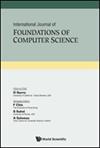交换交叉立方体的宽直径和断层直径
IF 0.6
4区 计算机科学
Q4 COMPUTER SCIENCE, THEORY & METHODS
International Journal of Foundations of Computer Science
Pub Date : 2023-06-23
DOI:10.1142/s0129054123500107
引用次数: 0
摘要
故障直径和宽直径通常用于测量互连网络的容错性和传输延迟。图的[公式:见文]宽直径[公式:见文],用[公式:见文]表示,是最小整数[公式:见文],使得在[公式:见文]中任意两个不同的顶点,其内部至少存在[公式:见文]条长度最多为[公式:见文]的顶点不相交路径。[公式:见文]-图[公式:见文]的故障直径,用[公式:见文]表示,是在[公式:见文]中最多删除[公式:见文]个顶点后得到的生存图的最大直径。交换交叉立方体作为一种复合互连网络,如[公式:见文]所示,它同时具有交叉立方体和交换超立方体的理想特性,同时在并行计算系统的成本和性能之间实现了更好的平衡。在本文中,我们构造了[公式:见文]的任意两个不同顶点之间的内部顶点不相交路径[公式:见文]。此外,我们确定了[公式:见文]的[公式:见文]的宽直径[公式:见文]和[公式:见文]的故障直径[公式:见文]的上界和下界,即[公式:见文],这表明交换的交叉立方体比交换的超立方体具有更好的效率和可靠性。本文章由计算机程序翻译,如有差异,请以英文原文为准。
The Wide Diameter and Fault Diameter of Exchanged Crossed Cube
The fault diameter and wide diameter are commonly used to measure the fault tolerance and transmission delay of interconnection networks beyond traditional diameter. The [Formula: see text]-wide diameter of graph [Formula: see text], denoted by [Formula: see text], is the minimum integer [Formula: see text] such that there exist at least [Formula: see text] internally vertex disjoint paths of length at most [Formula: see text] for any two distinct vertices in [Formula: see text]. The [Formula: see text]-fault diameter of graph [Formula: see text], denoted by [Formula: see text], is the maximum diameter of the survival graph obtained by deleting at most [Formula: see text] vertices in [Formula: see text]. The exchanged crossed cube, as a compounded interconnection network denoted by [Formula: see text], holds the desirable properties of both crossed cube and exchanged hypercube, while achieving a better balanced between cost and performance of the parallel computing systems. In this paper, we construct [Formula: see text] internally vertex disjoint paths between any two distinct vertices of [Formula: see text]. Moreover, we determine the upper and lower bounds of [Formula: see text]-wide diameter and [Formula: see text]-fault diameter of [Formula: see text], i.e., [Formula: see text], which shows that the exchanged crossed cube has better efficiency and reliability than that of the exchanged hypercube.
求助全文
通过发布文献求助,成功后即可免费获取论文全文。
去求助
来源期刊

International Journal of Foundations of Computer Science
工程技术-计算机:理论方法
CiteScore
1.60
自引率
12.50%
发文量
63
审稿时长
3 months
期刊介绍:
The International Journal of Foundations of Computer Science is a bimonthly journal that publishes articles which contribute new theoretical results in all areas of the foundations of computer science. The theoretical and mathematical aspects covered include:
- Algebraic theory of computing and formal systems
- Algorithm and system implementation issues
- Approximation, probabilistic, and randomized algorithms
- Automata and formal languages
- Automated deduction
- Combinatorics and graph theory
- Complexity theory
- Computational biology and bioinformatics
- Cryptography
- Database theory
- Data structures
- Design and analysis of algorithms
- DNA computing
- Foundations of computer security
- Foundations of high-performance computing
 求助内容:
求助内容: 应助结果提醒方式:
应助结果提醒方式:


